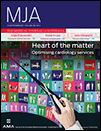The Cardiac Genetics Clinic: a model for multidisciplinary genomic medicine
Abstract
Objectives: To describe patient characteristics, standard operating procedure, and uptake of genetic testing at the multidisciplinary Cardiac Genetics Clinic (CGC) at the Royal Melbourne Hospital during its first 6 years.
Design: Database exploration of referral diagnoses, sex, number of clinic visits and incidence of genetic testing in a population of individuals attending the CGC.
Setting: Tertiary referral hospital (Royal Melbourne Hospital) providing cardiac genetics services to the state of Victoria.
Participants: All individuals initially attending the clinic between July 2007 and July 2013, either as the proband or as an at-risk family member.
Main outcome measures: Classification of patients into diagnostic categories, number of probands and at-risk relatives assessed, incidence and outcomes of genetic testing.
Results: 1170 individuals were seen for the first time over the 6-year period; 57.5% made only one visit. The median age was 39 years. Most were encompassed within four broad diagnostic categories: cardiomyopathy (315 patients), aortopathy (303 patients), arrhythmia disorders (203 patients) and resuscitated cardiac arrest and/or family history of sudden cardiac death (341 patients); eight patients had “other” diagnoses. Genetic testing (mutation detection or predictive testing) was undertaken in 381 individuals (32.6%), and a pathogenic mutation was identified in 47.6% of tests, representing 15.3% of the total population.
Conclusion: The CGC fulfils an important role in assisting clinicians and patients by reviewing genetic cardiac diagnoses. Clinical practice during the study period moved from a selected candidate gene approach to broader gene panel-based testing. This move to next-generation sequencing may increase the detection of mutations and variants of unknown significance. A major contribution by the clinic to the care of these individuals and their families is the provision (or negating) of a diagnosis, and of a plan for managing risks of predictable cardiac disease.




